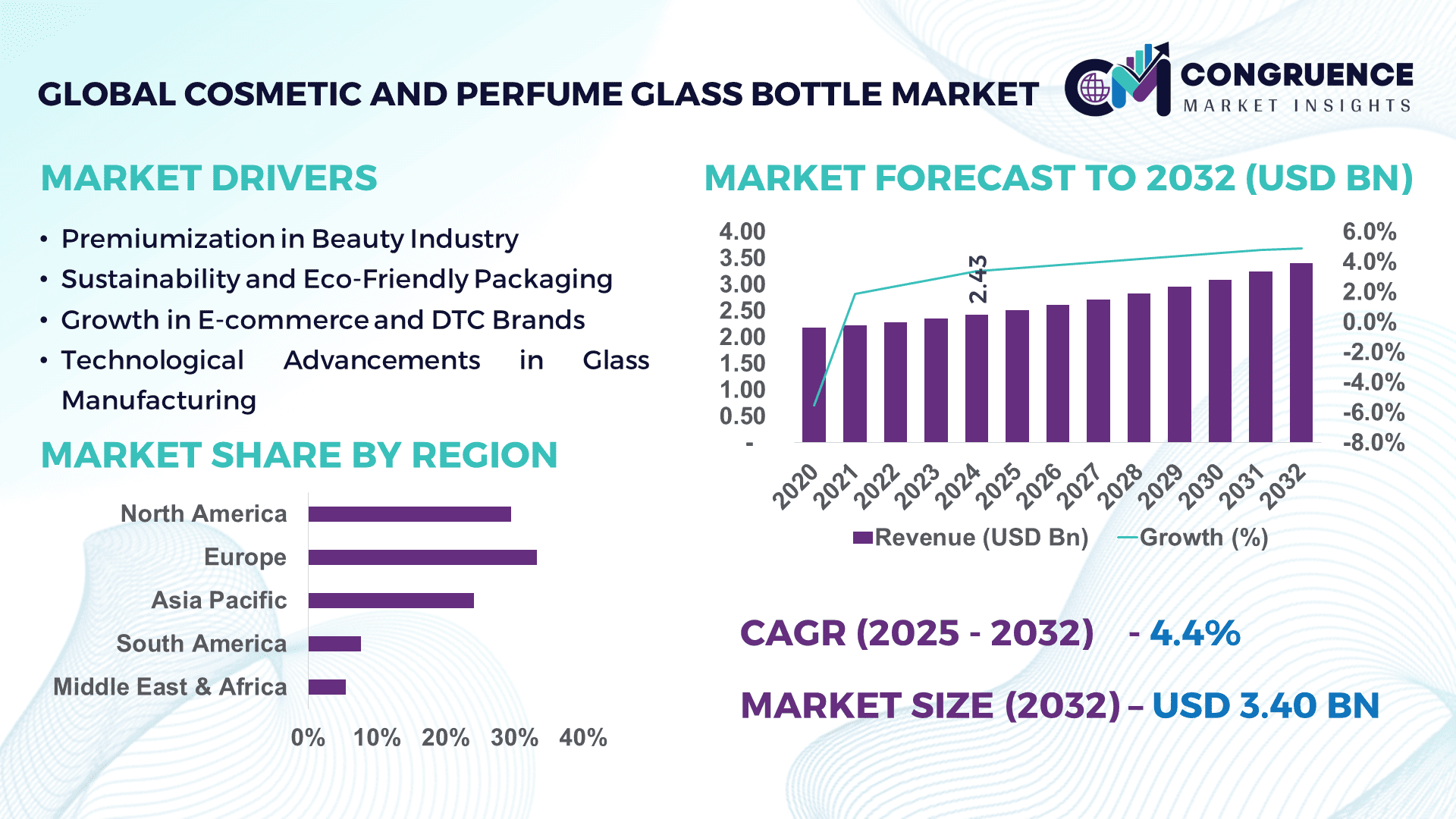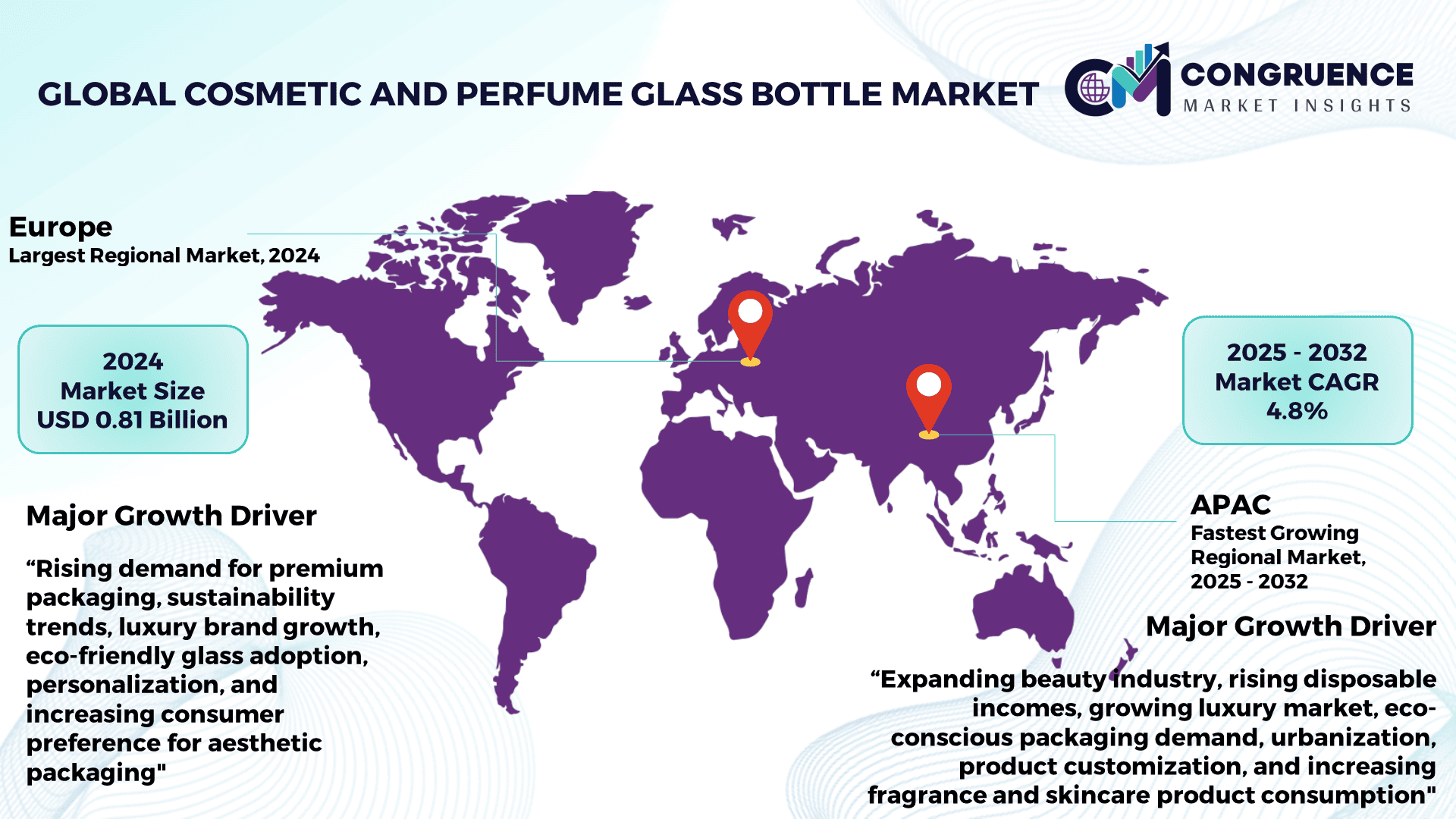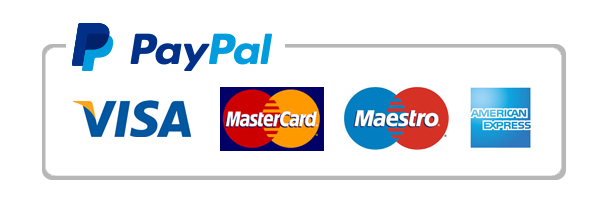Reports
Cosmetic and Perfume Glass Bottle Market Report Overview
The Global Cosmetic and Perfume Glass Bottle Market was valued at USD 2.43 Billion in 2024 and is anticipated to reach a value of USD 3.40 Billion by 2032 expanding at a CAGR of 4.4% between 2025 and 2032. Growth is being driven by expanding demand for premium and luxury fragrances, rising consumer expenditure on cosmetics, and environmental trends favoring recyclable and eco-friendly packaging.

To Learn More About This Report, Request A Free Sample Copy
The Cosmetic and Perfume Glass Bottle Market contributes significantly to the beauty and personal care industries by providing high-quality, long-lasting, and recyclable packaging solutions. Glass bottles have outstanding barrier qualities, which preserve the scent and efficiency of cosmetic formulas while increasing brand value through elegant aesthetics. As beauty firms focus on premiumization and distinctiveness, glass packaging remains a popular choice for perfumes, skincare serums, and essential oils.
The growing demand for sustainable packaging solutions has fueled innovation in glass bottle manufacture, with companies investing in lightweight, environmentally friendly, and refillable glass bottles. Technological developments in decoration techniques, including as screen printing, metallization, and engraving, are increasing the appeal of fragrance and cosmetic packaging. The growth of independent beauty businesses and direct-to-consumer (DTC) sales strategies is driving up demand for aesthetically pleasing glass packaging.
How AI is Transforming Cosmetic and Perfume Glass Bottle Market
Artificial intelligence (AI) is transforming the cosmetic and perfume glass bottle market by streamlining design, optimizing manufacturing processes, and increasing supply chain efficiency. AI-powered design tools allow for personalized bottle forms and complex engravings, shortening time-to-market for new product launches. Brands use AI to predict consumer preferences, resulting in personalized fragrance and skincare packaging targeted to specific demographics.
AI-powered robotic automation in glass manufacturing and decorating improves precision while minimizing faults and waste. Smart manufacturing solutions that use computer vision and predictive maintenance can monitor production lines, maintaining consistent quality and reducing downtime. Furthermore, AI-powered inventory and demand forecasting tools allow enterprises to optimize production schedules, eliminating surplus stock and increasing supply chain resilience.
AI also improves consumer engagement with smart packaging developments. Customers can learn more about fragrance compositions, ingredient sourcing, and recycling instructions by using interactive perfume bottles with RFID tags and QR codes. In the sustainability domain, artificial intelligence assists businesses in analyzing lifecycle assessments of glass packaging, identifying potential for carbon footprint reduction and sustainable raw material sourcing.
Cosmetic and Perfume Glass Bottle Market Major Driving Forces
· Premiumization in the Beauty Industry: The growing demand for luxury perfumes and high-end skincare items is fueling the desire for premium glass packaging. Luxury brands use high-quality glass bottles with elaborate decoration to strengthen their brand identity.
· Sustainability & Environmentally Friendly Packaging: Customers demand recyclable, reuse, and plastic-free options. To lessen the environmental impact of glass bottles, manufacturers are designing lightweight and refillable versions.
· Growth in E-commerce and Direct-to-Consumer Brands: The rise of direct-to-consumer (DTC) cosmetic firms is driving demand for visually beautiful, long-lasting, and customizable glass bottles that improve the unboxing experience.
· Technological Advancements in Glass Manufacturing: Technological advancements in glass manufacturing include ultra-lightweight glass, frosted coatings, and smart packaging technologies, which improve the appearance and usefulness of glass perfume and cosmetic bottles.
Cosmetic and Perfume Glass Bottle Market Key Opportunities
· Rise of Refillable and Sustainable Packaging: As firms shift toward circular economy models, there is a growing demand for refillable perfume bottles and eco-friendly skincare packaging.
· Emerging Indie and Niche Beauty Brands: Small and independent beauty brands are driving demand for unique glass bottle designs and low-MOQ (Minimum Order Quantity) packaging solutions, creating opportunities for specialised producers.
· Technological Integration in Packaging: Emerging trends in packaging include AI-powered smart glass bottles with digital labeling, scent recommendations, and RFID tracking, which provide a competitive advantage.
· Growing Demand in Asia Pacific: With a 4.8% CAGR growth rate, Asia Pacific has considerable prospects for luxury and mass-market glass packaging, driven by rising urbanization and disposable income.
Cosmetic and Perfume Glass Bottle Market Key Trends
· Customers choose engraved, embossed, and color-customizable glass bottles for a distinct, luxury experience.
· Manufacturers are lowering bottle weight to reduce carbon footprint while preserving durability.
· RFID-enabled perfume and cosmetics bottles improve traceability and customer contact.
· Brands are creating refill stations and glass bottle take-back programs to support environmental aims.
· The popularity of hybrid glass designs, which combine glass with metal caps, ceramic accents, or wooden closures, is growing because to their premium appearance.
Region-wise Market Insights
Europe accounted for the largest market share at 33.2% in 2024 however, North America is expected to register the fastest growth, expanding at a CAGR of 4.8% between 2025 and 2032.

To Learn More About This Report, Request A Free Sample Copy
Europe dominated the market in 2024, owing to high demand for luxury perfumes and environmental legislation that encourage recyclable packaging. France, which is the center of luxury fragrance manufacturing, dominates the region's glass packaging business.
· In October 2024, Heinz-Glas introduced an innovative glass closure to its standard range. This addition enhances sustainability and premium packaging solutions by offering a recyclable alternative to traditional closures.
Asia Pacific is the fastest-growing market (CAGR 4.8%), driven by rising disposable incomes and increased beauty product use in China, Japan, and India. Local cosmetic businesses and foreign players are expanding manufacturing in the region, driving up demand for glass bottles.
North America has a strong luxury and mass-market beauty business, with increasing investments in ecological packaging. The United States dominates the industry, focusing luxury skincare and clean beauty items in glass packaging.
Latin America, the Middle East, and Africa are seeing greater investment in local perfume manufacture, as demand for customizable and affordable glass bottles grows.
Recent Developments
· In February 2025, negotiations were underway for the acquisition of Verescence, a global leader in luxury glass packaging. The deal, if finalized, could impact the high-end fragrance and cosmetics packaging industry.
· In September 2024, Bormioli Luigi partnered with Penn State to develop sustainable glass for cosmetic packaging. The collaboration aims to enhance eco-friendly glass production techniques, supporting the beauty industry's shift toward greener packaging solutions.
· In September 2023, SGD Pharma introduced new glass packaging innovations, including mini fragrance samplers and a refillable jar. These products aim to enhance sustainability and convenience in the beauty industry.
· In April 2022, Sibelco contributed to the creation of a perfume bottle made with high-purity recycled glass. This initiative highlights the potential of sustainable materials in luxury packaging, promoting environmental responsibility within the fragrance industry.
Market Competition Landscape
The Cosmetic and Perfume Glass Bottle Market is very competitive, with top competitors prioritizing sustainability, innovation, and premiumization to preserve their market positions. Major producers, including Verescence, Pochet du Courval, and SGD Pharma, dominate the luxury category by providing high-quality, personalized glass bottles with advanced decoration techniques. Bormioli Luigi, Gerresheimer AG, and Piramal Glass prioritize lightweight, environmentally friendly, and refillable packaging solutions to fulfill changing consumer demands.
Strategic alliances with premium and mass-market beauty companies are essential for market growth. Companies are investing in smart packaging technology such as RFID-enabled bottles and AI-powered customization to improve brand distinctiveness. Furthermore, sustainability initiatives, such as the utilization of recycled glass and carbon footprint reduction plans, are important competitive factors.
With rising demand in Asia Pacific and North America, regional businesses are expanding investments in manufacturing capabilities and environmentally friendly innovations, heightening global competitiveness.
Key players in the global cosmetic and perfume glass bottle market implement various organic and inorganic strategies to strengthen and improve their market positioning. Prominent players in the market include:
· Verescence
· Pochet du Courval
· SGD Pharma
· Bormioli Luigi
· Gerresheimer AG
· Vitro Packaging
· Heinz-Glas
· Piramal Glass
· Stoelzle Glass Group
· Beatson Clark
· Zignago Vetro
· Lumson S.p.A.
· Saver Glass
· Baralan
|
Report Attribute/Metric |
Details |
|
Market Revenue in 2024 |
USD 2.43 Billion |
|
Market Revenue in 2032 |
USD 3.40 Billion |
|
CAGR (2025 – 2032) |
4.4% |
|
Base Year |
2024 |
|
Forecast Period |
2025 – 2032 |
|
Historical Data |
2020 to 2024 |
|
Forecast Unit |
Value (US$ Bn) |
|
Key Report Deliverable |
Revenue Forecast, Growth Trends, Market Dynamics, Segmental Overview, Regional and Country-wise Analysis, Competition Landscape |
|
Segments Covered |
· By Type (Perfume Bottles, Skincare Bottles, Nail Polish Bottles, Essential Oil Bottles, and Others) · By Shape (Round, Square, Oval, Rectangular, and Custom Shapes) · By Capacity (Below 50ml, 50ml – 100ml, 100ml – 200ml, and Above 200ml) · By End-Use (Luxury Brands, Mass Market, Indie Brands, and Private Labels) |
|
Geographies Covered |
North America: U.S., Canada and Mexico Europe: Germany, France, U.K., Italy, Spain, and Rest of Europe Asia Pacific: China, India, Japan, South Korea, Southeast Asia, and Rest of Asia Pacific South America: Brazil, Argentina, and Rest of Latin America Middle East & Africa: GCC Countries, South Africa, and Rest of Middle East & Africa |
|
Key Players Analyzed |
Verescence, Pochet du Courval, SGD Pharma, Bormioli Luigi, Gerresheimer AG, Vitro Packaging, Heinz-Glas, Piramal Glass, Stoelzle Glass Group, Beatson Clark, Zignago Vetro, Lumson S.p.A., Saver Glass, Baralan |
|
Customization & Pricing |
Available on Request (10% Customization is Free) |
